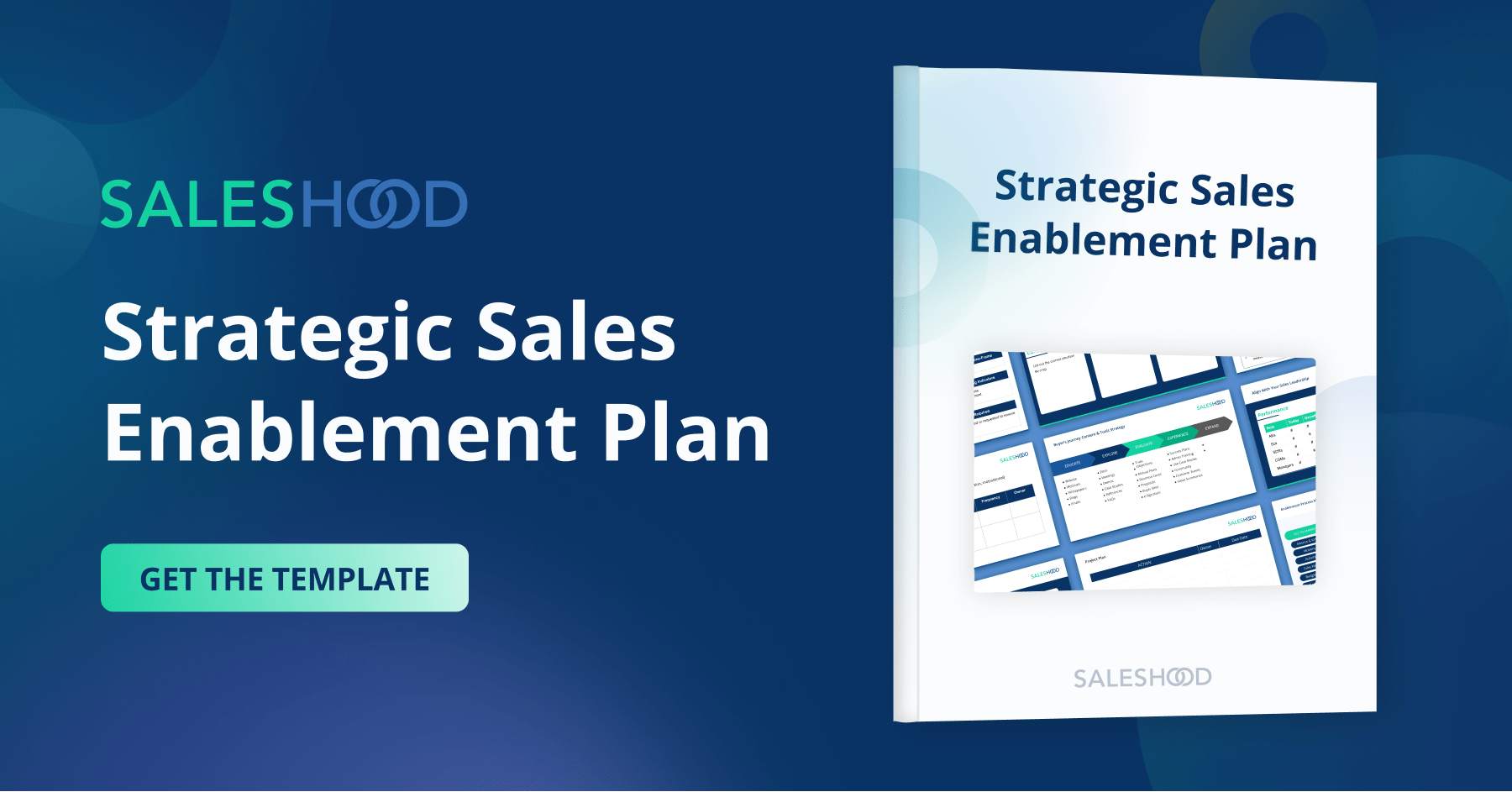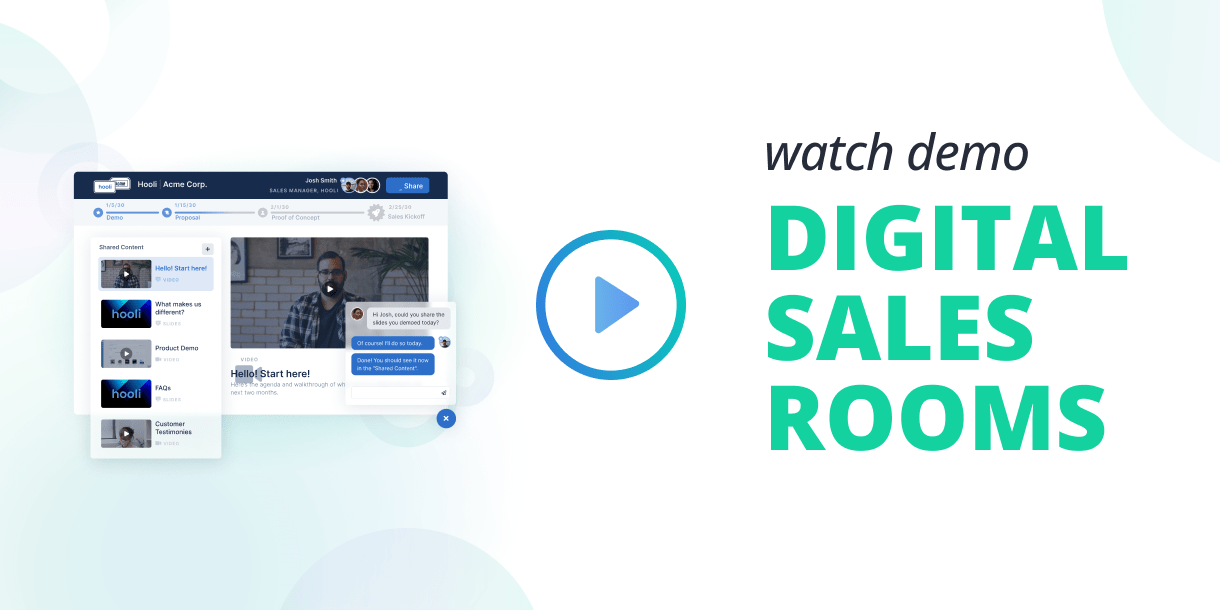Investing in sales enablement is an important step for a company to take, and it might seem like a long shot to those who think that it’s only about training.
Sales enablement is not only about training. It is about being the stewards of corporate resources, creating content, and pushing it into the right hands at the right time. It’s about being in charge and being accountable – and about creating ambitious success plans while keeping the company message on point, and everyone’s eyes on the prize.
Building an enablement practice is also about building a successful infrastructure of content, and a renewing network of feedback and improvements to the sales process that can be made in real-time.
The Four-Pillar Structure for Sales Enablement Teams
Sales enablement teams trained and developed with SalesHood methods have been successful at skyrocketing their results and growth.
Sheevaun Thatcher of RingCentral is the head of sales and growth enablement. Her take on sales enablement structure includes the four pillars that help to hold up her enablement practice.
She uses the four-pillar structure to keep her sales enablement crew of over 50 team members focused:
1) Did They Get the Memo?
Is the go-to-market strategy established and is it a good one? Very often, the sales team is a bit like Narcissus staring at his own reflection – and not looking around enough. It’s important to make sure that the go-to-market strategy is about everyone in the company – after all, your whole organization is a powerful machine. It works as a whole, even if it’s made up of different parts. You want everyone in the company needs to be on the same page.
Sales enablement practices a lot of message building and making sure that everyone is mission conscious. They connect people throughout the company – this is a very important job that often gets overlooked.
Everyone knows that it’s important to communicate with other teams, but it gets left for last and forgotten because of tight schedules and being unable to look outside of our own box. Often, we assume others know what we do. The truth is – they don’t unless someone tells them and manages the message. The seemingly simple question of “what does your company DO” needs to resonate loud and clear with every member of every team.
2) Do They Have Everything They Need?
Your company is full of internal knowledge that is useful to the sales team. Every department and every team contributes to sales – product development, design, marketing, HR, and engineering. But is this information easily accessible to your sales team so they can pull it out of their hat at exactly the right time?
Each and every one of these teams is busy with their own goals and schedules – sales enablement’s job is to connect the dots and to take all the useful content that your teams produce (or even create user-friendly content based on data that the teams collect) and plug it into a library that is searchable, and makes relevant, on-message content available exactly when your sales team needs it most.
This leads us to the third pillar:
3) Are You Delivering the Right Content at the Right Time?
As a sales team, it’s difficult to obtain the information you need at the time you need it – and this isn’t because it isn’t available. Think about it this way – you are a Nascar racer, and every time you make a pit stop you jump out of your car, and start rifling through the toolbox to find the right equipment to change your tires.
You know you need your tires replaced in order to win the race. You know you need them right now. All the tools are right there. And yet you fumble and discover that even a professional driver will lose the race unless there is someone with them at the pit stop, pushing the right tools.
Sales enablement provides sales organizations with a pitstop crew that will push the right content at the right time. Effective sales enablement will make a seamless content pass, and give your salespeople exactly what they need at the right point in the sales funnel.
In order to do that, they need to build a network of information, content, and training throughout the whole company.
The keywords for sales enablement best practices are “right place and right time” – training has to be smart. How often have you seen a person who is only just beginning their employment journey get crushed with an avalanche of sales training that they can’t use?
Of course, the right time will come, and they will need all of these tools eventually. But when training information comes at the wrong time, it will get lost. You will lose time retraining people all over again, and they will waste their time searching for information they “know they’ve seen somewhere” but can’t quite place it when it comes time for them to use it.
The sales enablement function is connecting training at the right place at the right time, to the right employees at the right point in their journey.
4) What Works and What Doesn’t?
Sales and marketing teams are known for forging their way ahead and sometimes they forget to look back and assess what is working and what isn’t. Looking at what is working and what isn’t is key to successful sales because it prevents from continuing to put resources into plans and solutions that simply don’t work.
This is where you need to hear from the sales reps in the field – they are your best source of information for determining what is and isn’t working. The flow of information is vital and produces immediate responses where they need to happen most.
Just the same, when someone is doing something right and has found something that works best for them, a successful sales enablement team will make sure that this information spreads to everybody else and turned into content and training materials that everyone at the company can use.
Sales Enablement Immersion in the Sales Process
The training process takes place not only at the very beginning of these four pillars of sales enablement. Sales enablement function is such that your organization will be immersed in training at every point of the sales cycle, and in every team. The enablement process happens when your teams (not only sales and marketing) are effectively coached, pushed, and connected by sales enablement professionals.
These enablement professionals need the right level of knowledge, content, and information to make this process successful. They are the master communicators, simply because as you probably realize – communicating within large sales organizations is a full-time job. Effective sales enablement becomes the master communicator – it’s their job to see the full picture while other teams like sales and marketing concentrate on their goals.
A sales enablement professional works as a messenger between the sales teams and HR, marketing, and all other teams found in sales organizations. They are out on the front lines gathering crucial information from the sales reps in the field, and bringing it back to the rest of the team – this is how quick solutions are found and enabled.
So you see, it’s not only about sales training – but it’s also about quick reactions to the market and clients’ needs. This is why sales enablement is really enablement by “push” and not by a “do what we say” approach.
Sales Enablement as Understood Through the Internal Marketplace
One way to see the sales enablement program that is accountable and measurable is to look at it through the lens of an internal marketplace -that is to say, a “business within a business”.
For example, your investors are the CEO, the COO, CFO, and SVP Sales. They are the people that fund you and that have entrusted you with a mission to fulfill. You will control your projects, but you report back to them.
Similarly, you can report to different departments as well. The pure advantage of reporting to the CEO or the COO is that there is a feeling of being “centralized”. If sales enablement reports to the marketing team, there is a danger of them assimilating to the marketing team and the marketing team’s problems.
In contrast, if sales enablement answers to HR, there is a real danger of them being channeled into becoming a purely onboarding and training outfit, rather than being a wide problem solver and playing an active role in acting as a real-time catalyst for turbocharging sales.
In a situation where you’re dealing with an internal market place for sales enablement, the supply chain is represented by the teams within your organization that deal with marketing, engineering, or product management. Your customers or people you have to please are the sales managers and frontline managers. The very end users are the sellers or the people on the front lines.
We love this kind of system because it clearly explains the role of sales enablement.
It also keeps the budgets on track and forces the whole sales enablement team to be responsible for their outcomes. They never quite sit back and relax at their desks, but are constantly aware that they have a job to do within the company and are held accountable for all of their measured success.
Creating Accountability in Sales Enablement
When you make good on your promises and goals, you can ask for more. In an internal marketplace, you know that you are only as good as your results, and your losses and gains don’t get lost in the system.
A sales enablement team will partner with sales managers and frontline managers in order to create a lasting relationship with them. It is a business relationship in a sense because they end up becoming the customers that you have to please.
When you treat your sales teams like your clients, you start thinking in terms of what products they need in order to be happy. What problems are you solving for them and how can you show them what you’re doing to improve their results?
A successful and proactive sales enablement team will then go to the supply chain and weave all of their product data into easy to digest, beautiful and informative pieces of content that the sales team (or their client) can use. This is where your marketing team comes in.
Did you know that the majority of marketers come up with amazing ideas that never actually get used? That’s right. But why is that? Could it be that they’re not presenting the content correctly? Or maybe they’re not concentrating on the correct questions that need answering?
Let’s all be Responsible
Your salespeople will become crucial partners in sales enablement. They have to be on board and be 100% willing to help you help them.
What does this mean, exactly? It means that in order to work as a team, you have to become a team – a team of peers who are all driven to achieve the same goals – but at the same time, you have to keep in mind that each key player has their own responsibilities and cannot be responsible for the other one.
This means, in a nutshell, that while sales enablement is there to support, nurture and provide training and content – they cannot go out there and sell. This is still the job of the sales team, and it is up to them to skillfully use every piece of content and help that is provided to them by the sales enablement team.
Making Content That Gets Used
Sales enablement content is a specific type of content that has to be current, engaging, precise, and on-point. There is nothing worse than training material that has the character of a long and boring PowerPoint presentation. In order to get through to your sales managers and front end staff, you have to speak their language.
In fact, you have to be multilingual and speak the language of product management, marketing, sales managers, and investors in order to coordinate resources and content.
Training Your Sales Enablement Team
Many businesses start off small. It takes a while to develop a well-working team. As you make progress, you realize and take note of the different skills needed for different kinds of challenges. These are all distinct to your own organization, and the types of people you train, how you train them, and the way that your team will be segmented and structured will all boil down to what works the best for you and what your goals for sales enablement are.
As with every new program or initiative, no company is going to throw money at it from the start. Sales enablement has to prove that it will not only feed itself but feed itself enough to grow and expand. Once your team starts making deep progress and accelerating sales, it will show that it needs and deserves more funding.
Over time, results tracking and keeping tabs on your events will produce data that will let you know where you should invest more and what is working best for your organization.
Have a Formal Charter
One of the most important things you have to do when you begin building your sales enablement practice is to create a charter. This is a Sales Enablement plan that can deliver ROI and inspire your team to push harder and be more creative in what they do.
The fact is that sales enablement works much better when it has a charter – it’s something that connects actions and efforts with the goals you have set for yourself (usually quarterly). In fact, almost half of sales enablement efforts in companies are run without a “formal” effort.
This is a shame, since the proven results of having a formal sales enablement efforts are rock-solid, and having a charter adds to the foundation of the whole enterprise. In addition, having a charter actually improves the win rate by about 19%.
Why is that the case? It’s because having a formal charter creates a responsible and streamlined approach to sales enablement – it becomes more than just an idea and more like a regimen that companies can enact and contribute to. And what’s most important is that it gets everyone on board.
How to Write a Sales Enablement Charter?
- Know your mission – look into your company’s mission plan and see what vision you want to put forward. Do you have a ready mission statement? This shouldn’t be anything like “we want to raise our sales by 20% in the next fiscal year”, but rather it should define how you plan on getting there. What are your problem-solving goals? What do you expect of your salespeople? In a perfect world, how do you see your selling state in a year? Two years?
- Define your metrics – when measuring how sales enablement will help you to reach your objectives, you need to set a few mileposts. Or kilometer posts. You need to know how you’re going to measure your success. KPIs, or Key Performance Indicators are crucial in helping you name the measuring stick that you’re going to use when measuring your progress. Is it the hours you put in? Or the number of different tasks performed? What is your base unit? One of the most important jobs of sales enablement is to measure results – make sure you define how to do it.
- Who is your customer? Like we talked about before, your customers aren’t necessarily your company’s actual clients. They are most likely going to be the sales teams and their leaders and sales managers. They are the ones that you need to work with and who’s expectations and needs you need to meet. Talking to them is crucial in establishing goals for this type of customer relationship. What do they need? How should you make your teamwork seamless?
- Build a structure – a solid structure is the basis of a well functioning sales enablement team. This structure needs to be well defined and enforced. This is actually a long list of things that will make it possible to roll out the sales enablement plan throughout your whole company and to have everyone on board from the start. It’s easier to set a perfect rollout than to try to fix it later.
- Assign roles to stakeholders so they will participate to the fullest – The best way to engage your stakeholders is to create an atmosphere of accountability (and excitement)! This is a sure way to get them to participate – and participation is the number one factor of success in sales enablement.
- Take inventory – what kind of enablement content, services, and resources do you already have and provide? These will give you and your team an important jump-start in creating resources and using what you already have available to you.
- Choose your leaders – in order to build accountability and organize better, you need to define leadership and an advisory board. You will report to the project owner (most likely in the CEO, COO, or CFO team). Sometimes, sales enablement reports to sales or marketing, or even HR.
- Define your role and services – this will start off great communication between you and the rest of the company. Once everyone knows what processes you’re responsible for, what you provide and what to expect, they will know how to work better with you and how to use sales enablement to their advantage.
Get the Right Sales Enablement Tools
In conclusion, the beginning of the sales enablement building process is probably the most strategic part of the whole method. Once you have the right strategy and tools, the most important things you need to worry about are the commitment to the process from other teams, consistency, and accountability. Read more about the resources that we offer to companies that are just starting out with their charter, or are just wondering how to take the first bite out of sales enablement in our Resources section.



